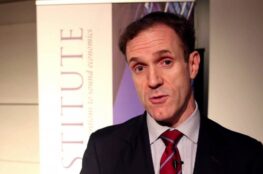Addendum, 1/20/2015: A commenter on this post alerted me that I seem to have misread Wolfe’s point about neoconservatism being one branch of conservatism rather than including the other branches he listed as part of his definition of neoconservatism. Since neoconservatism is, in numerous circles, conflated with various forms of neoliberalism, classical liberalism, and libertarianism, I am going to leave the original post up as it may be helpful to some audiences. However, it appears that Wolfe himself is not making this interpretive error. My apologies for the confusion.
A friend directed me to Artur Rosman’s interview with Gregory Wolfe, editor-in-chief of IMAGE Journal. It’s available at Ethika Politika here. The main topic of the interview—Catholic literature—is one I don’t find particularly compelling, but to each their own. What caught my eye was Rosman’s question about Wolfe’s relationship to neoconservatism and the puzzling reply Wolfe made: “Let’s get some terminology straight: neo-conservatism is a branch of the larger conservative coalition, which includes traditionalists, libertarians, and a couple other exotic species. It loses any value if it is simply used to mean ‘modern conservatives.’”
Is it? In an earlier post, “Neoconservatism and Conceptual Clarity,” I endeavored to sort out the conceptual confusion which emerges when neoconservatism is conflated with libertarianism. Wolfe, apparently, sees them as one in the same, which makes very little sense. At the level of foreign policy—the place where neoconservatives tend to distinguish themselves from other conservative orthodoxies—the two camps are radically different. Although some exceptions may be found on the periphery, libertarians, by and large, disavow interventionism and some go so far as to espouse isolationism.
The Cato Institute, which is broadly representative of contemporary libertarian thinking, charts a middle course, “argu[ing] that the United States should be an example of the principles of liberty, democracy, and human rights, not their armed vindicator abroad” and, moreover, “should remain engaged in the world through trade, tourism and other cultural exchanges, and welcome those from around the world who want to work, study or invest here.” This attitude of restraint contrasts sharply with the tried-and-failed neoconservative policy of “exporting democracy” through various forms of direct and indirect intervention, up to and including military action.
As I also discussed in my previous post on this topic, neoconservatives tend to be less willing to genuflect before the power of the “Invisible Hand” than their estranged libertarian brethren. Irving Kristol, the godfather of neoconservatism, had a much more modest view of capitalism than both libertarians and classical liberals. As a whole, neoconservatism contemplates that certain market matters cannot be solved by economic science and that government regulation is not harmful per se. In fact, neoconservative “laxity” on free-market disciplines has been a frequent source of frustration for mainline conservatives, many of whom blame the “neoconservative reign” of George W. Bush for starting the country down a dark economic path during the 00s.
Some may see these distinctions as trivial, but they are not. Clealry Wolfe does not think so since, in the same interview, he briefly summarizes his own former conservativism as “paleo” meaning “Burkean traditionalism.” (How “Burkean traditionalism” differs from the “traditionalism” Wolfe detects in neoconservatism is not elaborated.)
Recognizing the differences between various political camps and movements, whether or the Left or the Right, is essential for the larger project of critiquing and overcoming liberalism. (Libertarians, neoconservatives, and paleoconservatives are all, at the end of the day, offspring of liberal ideology.) A principled attack on the mythic idea of the “free market” may upset the second reality in which most libertarians dwell, but it can be parried with ease by neoconservatives who recognize a more-than-modest role for government economic intervention. Similarly, casting light on the moral and practical pitfalls of neoconservative hawkishness will likely be met with approval by libertarians.
At the close of business, of course, a thoroughgoing critique of liberalism itself, in all of its manifestations, is required. That so few who quarrel with this-or-that wing of liberal ideology are unwilling to do this, being themselves invested with liberalism, is not surprising. It is, however, unfortunate.



